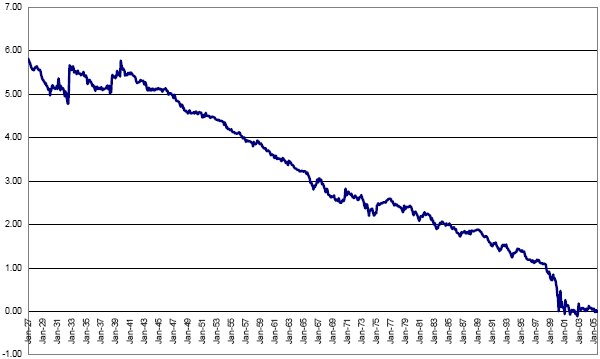Has the focus of investors/traders (especially hedge funds) on stock return momentum, the persistence of outperformance and underperformance, killed the effect? In their March 2007 paper entitled “The Disappearance of Momentum”, Soosung Hwang and Alexandre Rubesam investigate trends in the momentum effect over a long period. Their baseline analysis examines sets of ten momentum-ranked portfolios formed on past five-month returns and held for six months, with an intervening month skipped. Using monthly return data for a large number of individual NYSE, AMEX and Nasdaq stocks over the period July 1926 through December 2005, they conclude that:
- Over the entire sample, the average monthly momentum effect (return on top 10% minus return on bottom 10%) is +0.92%. However, on a risk-adjusted basis, momentum returns are significant in only four or five of 16 adjacent five-year intervals.
- There are major breaks in the momentum effect in 1939 and 2000. The effect is strong in the middle interval (1939-2000), but much weaker before 1939 and after 2000. Since 2000, the momentum effect alpha is negative on average, and about 70% of the return distribution is negative. An investor initiating a momentum strategy at the beginning of 2000 would have accumulated no profit through June 2005.
- The disappearance of the momentum effect since 2000 suggests that its discovery for 1939-2000 could be an artifact of data snooping bias.
- Results are robust to portfolio variations (based on firm size or NYSE stocks only), formation periods and holding periods.
The following chart, taken from the paper, shows the cumulative profit of the baseline momentum strategy per $1.00 invested long, according to strategy initiation date. Strategy portfolios are long the top 10% of stocks and short the bottom 10% based on five-month past returns. Portfolios are formed monthly and held for six months. For example, an investor initiating the strategy in the middle of the 1980s (the late 1990s) would have earned about $2.00 ($1.00) for each $1.00 in the original long position. If the momentum effect were reliable in all intervals, then the cumulative profit should be consistently higher for earlier start dates — the graph should decline steadily from the earliest start date to the latest. The chart shows that momentum effect profits: (1) did not reliably accumulate during 1927-1939: (2) accumulated with substantial reliability during 1939-2000; and, (3) are non-existent since 2000.

In summary, the stock return momentum effect wasn’t there, then it was there for a long time, and now it’s gone.